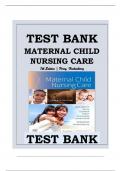, TEST BANK FOR MATERNAL CHILD NURSING CARE
7TH EDITION BY SHANNON E. PERRY, MARILYN J.
HOCKENBERRY, MARY CATHERINE CASHION
CHAPTER 1-50 COMPLETE GUIDE LATEST UPDATE
Chapter 01: 21st Century Maternity Nursing
1. The nurse should be aware that one of the most commonly mentioned maternal medical risk
factors, when giving care to a pregnant patient, is:
a. Diabetes mellitus. c. Chronic hypertension.
b. Mitral valve prolapse (MVP). d. Anemia.
ANS: A
2. The modern maternity nurse must include teamwork and communication with clinicians into
her care delivery to guarantee the best possible outcomes for the patient. The SBAR
communication approach is a simple mechanism that is easy to memorize. Which of the
following describes this acronym correctly?
a. Situation, baseline assessment, response
b. Situation, background, assessment, recommendation
c. Subjective background, assessment, recommendation
d. Situation, background, anticipated recommendation
ANS: B
,3. The focus of a professional nurse's care for families with children has changed to include:
a. Providing care to patients directly at the bedside.
b. Primarilyhospital care of maternity patients.
c. Practice using an evidence-based approach.
d. Planning patient care to cover longer hospital stays.
ANS: C
4. An African-American woman, age 23, is expecting her first child. Which plan is the most
crucial for the nurse to carry out, given the infant death statistics?
a. Perform a nutrition assessment.
b. Refer the woman to a social worker.
c. Advise the woman to see an obstetrician, not a midwife.
d. Explain to the woman the importance of keeping her prenatal care appointments.
ANS: D
5. A 21-year-old Hispanic patient with poor English proficiency is being assessed first by the
nurse during a prenatal intake session. It is imperative that the nurse:
a. Use maternityjargon in order for the patient to become familiar with these terms.
, b Speak quickly and efficiently to expedite the visit
c. Provide the patient with handouts.
d Assess whether the patient understands the discussion.
ANS: D




